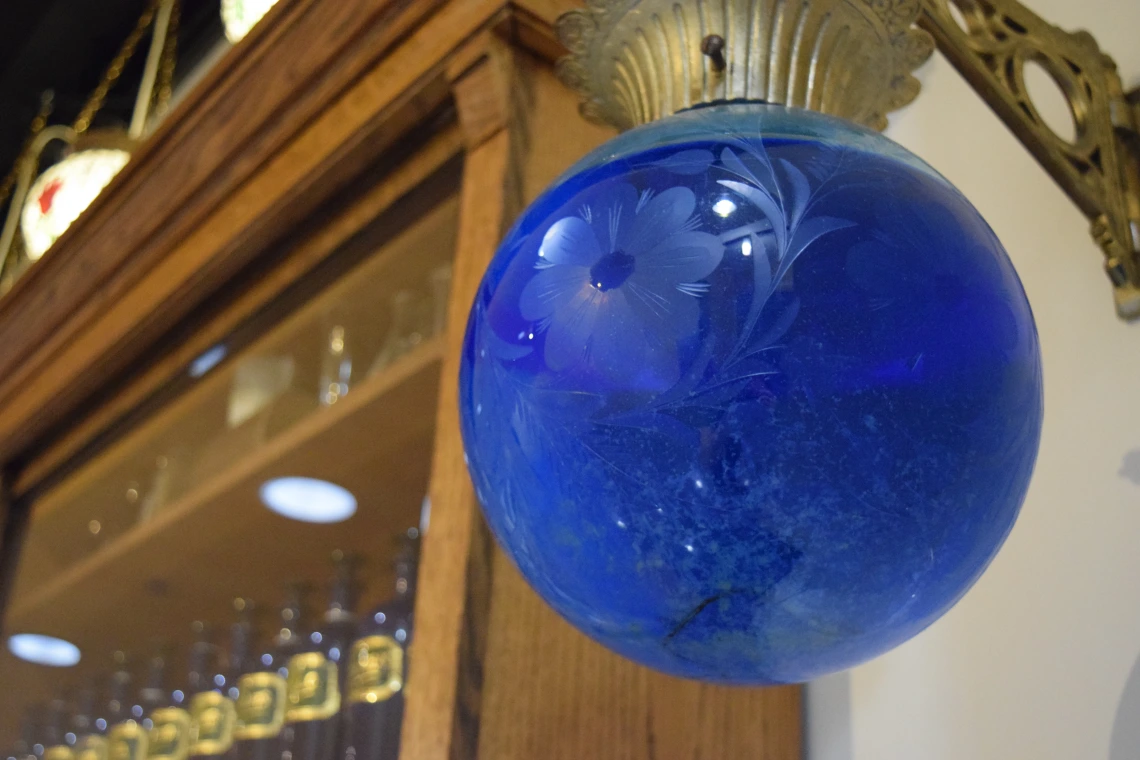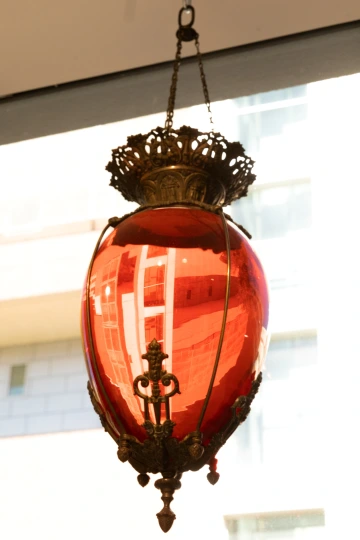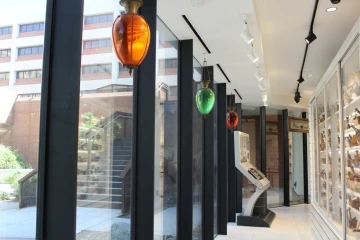The Mysterious Show Globe
Show globes are making a comeback—but where did they come from?

Their stunning glasswork and bright, vivid colors seem at once welcoming and a bit unnerving. They’re being snatched up by antique collectors willing to pay thousands of dollars for them. And they’re making a comeback in certain circles as unique, attractive pieces of art.
Yet for all the attention given to the show globe as an elegant symbol of the pharmacy profession, explanations of how they became pharmacy’s “barber pole” are as varied as the colored water they contain. Their mystery is due, in part, to the many legends of their origin.
When in Rome
The oldest and perhaps most colorful story posits that when Julius Ceasar and his army were invading Ireland, he needed a marker on the beachhead to guide his troops. A nearby apothecary served the purpose. Ceaser allegedly promised not to kill the shopkeeper if he would illuminate the show globes in his store window to serve as a “lighthouse”. The apothecary in this story is, however, highly anachronistic.
Another legend describes the globes as derived from urns used by pharmacists in the Middle East to store their wares. According to this story, travelers from Western Europe so admired the urns that they imitated them at home. If this were the case, show globes would have appeared all over Europe; in fact, they are almost exclusively Anglo-American.
Along similar lines is the theory that show globes are close cousins to maceration vessels, in which organic material is steeped in liquid in sunlight, just as “sun tea” can be made on sunny days. Although show globes could potentially be used for this purpose, it does not explain the use of brightly colored water in globes, not to mention that England is not famous for its sunny days.
According to “The Pill Rollers” by Lillian and Charles Richardson, “The show globe originated in the British Isles, but exactly where and when is subject to debate.”
More Disagreement

Many experts believe show globes were used by apothecaries during the Great Plague of London in 1665 to direct the sick to their shops, after healthy citizens and doctors had already fled the city. The steadfast apothecaries, it is said, used the bright liquid to communicate to the frightened public that medical attention was still available. How or why a short-lived, emergency symbol of health care grew to be a trademark for pharmacy remains to be answered.
There is also disagreement about the colors used in the first show globes to represent arterial and venous blood, while others such as the Richardsons, postulate that show globes first appeared in apothecary shop windows along coastal regions in England, “where they were filled with red and green liquid copying the running lights of ships to show sailors where to go when they needed medical attention.” There is also the “stoplight” theory of the show globe colors, which says that after the globes had made it to Colonial America in the early 1600s, red and green were standard colors: red indicating that the town had some kind of illness or quarantine (as a warning to travelers), and green representing a healthy welcome.
So, whom can we believe? Are there any documented references to show globes in historical literature to which we can point to dispel these legends?
Enter George Griffenhagen
There are—or aren’t, as the case may be. During the 1950s, the work of pharmacist George Girffenhagen, one-time acting curator of the Smithsonian Institution’s division of medicine and health, laid to rest some of the stories swirling around the origin of the show globe. The November 5, 1956, issue of American Druggist called his efforts “the most thorough investigation into the evolution of the show globe, based on personal research in Europe.”
Borrowed from Alchemists?
The most commonly accepted origin of the show globe as a pharmacy’s trademark took place during the merger of apothecaries and alchemists sometime during the mid-16th to mid-17th centuries. At the time, apothecaries (or druggists) sold medicinal products derived from natural and organic substances, while alchemists (or chymists) dealt with medicinal products made from raw chemicals. Many historians believe the globes originated with alchemists and their strange idea aura was representative of the secretive and mysterious group.
With the growing success of chemical therapies. Apothecaries adapted by gradually adding chemical remedies to their stocks, while adopting the globe as a way to bring in more customers. For a largely illiterate public, the globe was an intriguing and simple symbol to recognize.
Although it has been conjectured that England’s alchemists began to use liquid-filled globes as early as the 1500s, Griffenhagen’s research failed to reveal the vessels among their symbols. A somewhat later date, then, is the probable origin of the show globe. As the Richardsons have written, “All of the theories seem to agree that [the globe] does date back to at least 1665,” which would bracket the range between the mid-16th to mid-17th centuries.
The first written account of the show globe as a specific symbol of pharmacy occurred in 1775 by a German visitor to London, who wrote in a letter: “The street looks as though it were illuminated for some festivity; the apothecaries and druggists display glasses filled with gay-colored spirit… [which] suffice many a wide space with purple, yellow, or azure light.” Griffenhagen found another written account from 1788 in a reference to the Argand Lamp, which had been invented in 1782 and was used by English chemists to keep their show globes illuminated at night, According to Griffenhagen, this would indicate that show globes were not common in pharmacies until about the middle of the 18th century.
Design
Show globes generally fall into two design types: freestanding and wall-mounted. Of the latter, globes either hang from brass chains or are perched on elaborate support arms attached to a wall. Freestanding globes vary in shape from rotund to skinny, often with cut glass stoppers or pouring spouts for tops. The most impressive freestanding globes- especially popular in the late 1800s- have multiple tiers with separate chambers for different colored water, tapering to a finial at the top. Before large-scale glass manufacturing existed, show globes were hand-blown and painstakingly etched by hand. Globes in store windows were often accompanied by a silvered sphere. For nighttime illumination, light was focused on the sphere and reflected onto the globes. This was especially attractive for globes with a punty-cut surface.
Of course, were it not for their colored water, show globes would be no more than attractive jars. Pharmacists have prided themselves on their ability to create vibrant colors using chemicals on hand in their shop. Getting just the right mix of colors took practice, even with a recipe book.
On Display

The Coit Museum of Pharmacy and Health Sciences
Of its impressive collection of show globes, the Coit Museum of Pharmacy & Health Sciences has 18 on display of varying shape, size, and color, all of which were on display in the Arizona pharmacies sometime during the last 100 years. The first globe to greet visitors of the Museum is a deep red and hangs from the mouth of a spiraled bronze dragon wall mount. It is especially brilliant during certain times of the year when it is struck by the morning sun. A similar globe is depicted in the original oil painting Territorial Pharmacist, on display in the administrative offices, in which artist Greg Singley has portrayed a scene from a typical pharmacy during Arizona’s territorial days.
The oldest globes in the museum’s collection, located in the third-floor alcove, date back to the 1880s. They are excellent examples of the three-tiered variety, with finely cut stoppers and etched exteriors. During Arizona’s pre-statehood territorial days, these kinds of globes were a common sight in pharmacies. Small, desktop globes are displayed in the third-floor elevator lobby, and two hanging globes can be seen in the first-floor territorial display.
A Lasting Symbol
Show globes became increasingly less common in this early part of the century as old pharmacies went out of business and new pharmacies chose not to display them. But renewed support for the globes in the 1930s (particularly by American Druggist) moved the Owens-Illinois Glass Co. to introduce a new style, with an electric bulb inside to illuminate the globe. Through the 1950s, American Druggist continued to urge pharmacists to bring back the shoe globe, terming it “the greatest trademark ever invented”.
While you’re more likely to see Zantac on display in your local pharmacy than a show globe, many independent retail pharmacies still have or are bringing back show globes as a nostalgic nod to pharmacy’s long history.

